INFOLUST: mobile tags
While online, consumers turn to search engines for help. However, along with the fact that both Google and Yahoo are trying to give users the possibility of mobile search, there is still uncovered territory: items from the real world.
This is true precisely where the constant interest and growing expectations of pampered consumers run into the harsh reality of silent buildings, merchandise, storefronts, posters, etc. Most of these objects are not able to communicate and answer questions like who, where, when and why , that is, to give the information that consumers are accustomed to count on online.
Without a doubt, this virgin info-market (INFOLUST) services market attracts a host of innovative solutions for 'ask and know'. Inspired by two-dimensional bar codes (barcode), universal shot-codes, SMS-codes, QR-codes and UP-codes appear. These codes are attached, pasted or printed on objects, which should make them “smarter”, giving them the opportunity to provide the necessary information or simply send the person to the relevant web page.
')
Obviously, this expands the infolasting ecosystem, bringing additional bonuses to inquiring minds, bravely plowing the spaces of this not simple real world. Next are a few illustrations that demonstrate what are modern infolastingovye services.
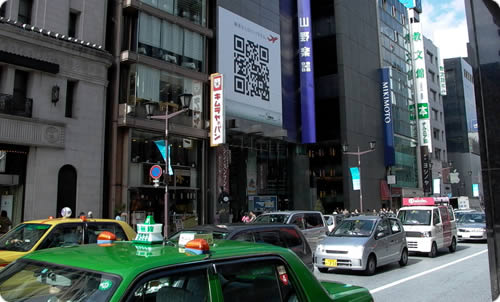
Initially, barcodes carried information in themselves, using parallel lines and spaces of different widths, but today they also use patterns from points, concentric circles, or it can be encrypted in some images. Although barcodes were originally created to transfer information about products to retailers, today this technology is rapidly pushed to the consumer (and even reproduced by the consumer himself!) To provide those who crave infolasting with the opportunity to communicate with their material environment.
Amazon ScanSearch | 27% of Japanese consumers already own cell phones that are capable of reading a bar code (source: eMarketer). This allows them to compare prices on the go: as early as November 2004, Amazon ScanSearch allows Japanese people to buy a book in a real store, read its bar code and compare it with a similar product in the Amazon.co.jp store, compare prices, and if there below, then purchase on her Amazon directly by phone.
ScanBuy | ScanBuy promotes a similar service in the USA called ScanZoom. After the buyer takes a barcode image on a product, he receives information about this product, which PriceGrabber or Amazon has, from its description and consumer ratings to prices in online stores.
According to ScanZoom, the following could be a service that will inform users about which of the nearest real stores offers a lower price for the same product.
QR code | At that time, as the barcode has information only in one single direction, the QR code ( QRcode ) places data both vertically and horizontally, which means it can hold a larger amount of information. Again in Japan, 30 million people have already installed special software for reading a QR code in their camera phones. A single image is enough and a QR square with information will be decrypted, and the user will receive additional information about the product through the built-in browser: from a web page to a themed video game and a promotional video.

Shot code | The OP3 ShotCode service was a visualistic solution on the infolasting market that consumers will surely like because, well, consumers generally love visualization. “Today, business cannot make people use their mobile phone to surf the Internet. The reason for this is that it is very long and inconvenient to type domain names on the phone. And here are Shot Codes: offline web links. Being captured on a mobile photo camera, the Shot-code immediately and without any effort takes the consumer to the appropriate web page directly by phone. Shot-code is easily created for any web address. " How it looks in life, you can see here: www.shotcode.com/data/movieformat .
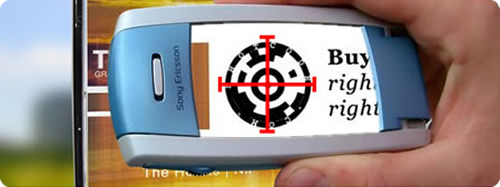
mCode | And one more! In the USA, Nextcode presented its mCode , a QR-like code, which can be given any shape, including the shape of a company logo. This code refers to consumer information, such as product information. It can be assumed that the code placed on the board in the passenger waiting room refers to information about the flight status, and the code on the movie poster sends to the movie trailer.

Up code | Finns also showed themselves by presenting their own QR code: Up code ( UPCODE ). Up-code is used by many popular Finnish newspapers: for example, after reading a report about a hockey game, the reader can, by sending his phone to the Up-code, download a video with all the goals, or get fresh financial / stock news, by sending the phone to Up- company specific code (source: Antti Kaiponen, Springspotter Network ).
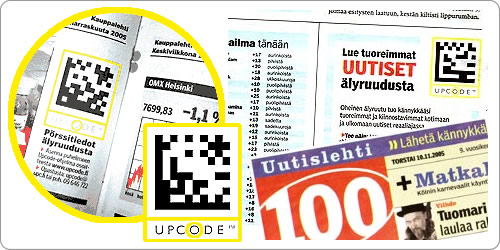
Color code | Four-color code The color code ( ColorCode ) is used in Japan and Korea. The color code refers to the corresponding server with digital content that is transmitted to the mobile device. This allows mobile phones, PDA and other devices to read pictures with a color code and immediately download music, video or data, be it family photos or a video clip of the World Championship 2006. Also, the Color code is used on TV, for example, by helping viewers to vote for your favorite reality show participants.

Mobot | Some pioneers of the grocery business do without special codes at all, for example, Mobot offers consumers to take a picture of an advertisement and send it to Mobot, having received information about this product in response. For example, working with ELLEgirl magazine, Mobot allows readers to purchase products, get free samples, discounts or product information from brands that they can choose. If a reader sees a pair of shoes in a magazine, then in order to find out the address of the corresponding store, you just need to send them a photo of Mobot. In addition, readers can participate in various promotions and games, as well as viral marketing campaigns that are sponsored by the brand. Mobot works with all wireless operators (no additional software is required) and advertising campaigns do not need to make any changes to existing existing media.

iScout | Mobot is by no means the only player on this field, and Neven Vision's iScout application helps mobile devices turn pictures into hyperlinks. “Users send some pictures of Neven Vision, which in return tells them some information about what is depicted on them. For example, send a photo with a painting and get an audio-visual story about this picture. Are you hungry? Just take a picture of the street and you’ll have a guide to the nearest restaurants on your phone. ”
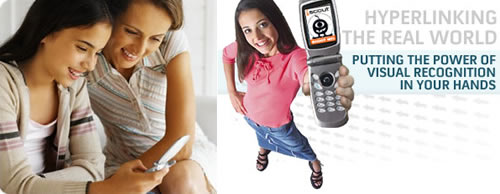
Photo Navi Wine | Similarly, Photo Navi Wine , an infolast application distributed by mobile content provider Zeta Bridge Corp, offers to take a picture of the label on a bottle of wine and get product information. It is enough to attach a photo with a label to the letter and send it to photo@wine55.jp, and within 15-20 seconds you will find out the classification of the wine and the country of manufacture. For restaurant visitors, this can be an instant sommelier. Sony's image recognition technology even recognizes blurry or warped images taken in dark rooms and can learn about 3,000 brands that Zeta Bridge has information about. About 500 brands can be ordered directly by phone (source: Asahi Shimbun).
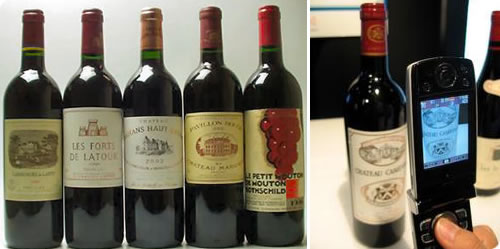
KoolTag | So far, we have been talking about codes created for consumers, but in the world of total CUSTOMER MADE and open-source, what about those codes that are created by consumers themselves ? Pay attention to the Singapore Tagit , which has developed a universal decoding system that works on an open platform, and can decode any type of digital codes, from a QR code and a primitive two-dimensional DataMatrix to its own Tagit-code product. But that's not all: the self-made part of this business is in the KoolTag service: “You can create a KoolTag for any message you would like to send to anyone. If you want your girlfriend to see a special secret picture, or to share with friends some personal video clip, it’s enough to create a KoolTag right on this site, print it, send it by email or just hang it in a prominent place. To view the contents of the KoolTag, you need only a cameraphone. KoolTag free service! ”.
The company expects to grow rapidly: Nokia, which owns 70% of the market in India, is going to include the Tagit application in all its multimedia phones, and in Singapore, Tagit, in collaboration with Sistic, the largest ticket distributor, is preparing to introduce a new mobile theater-viewing system. At the first stage, consumers will be able to receive their tickets to the mobile via MMS. Tickets will be sent in the form of a 2D barcode generated by the Tagit system. As the service develops, visitors will be able to use the full range of services, from watching a video trailer for a concert, choosing places, buying and receiving tickets, and all just by using a mobile phone. Tagit plans to move into the markets of South Korea, China and Europe.

Sema-code | Like the above QR code, the sema code is a two-dimensional matrix bar code that includes a URL. Using the Semacode Software Development Kit, any user can create visual tags for objects and contexts. Software that is installed on the phone of another user, will allow to find the corresponding mobile content. And since this is an open system, anyone can create as many semacode tags for any number of different URLs.

Among the interesting examples of how CUSTOMER-MADE intersects with infolasting, Semapedia can be called: users print links to Wikipedia articles in the form of a sema-code and attach them directly to the item or place to which the article is dedicated. Another example: Semacode Shop , which sells bloggers with T-shirts with a sema-code link to their personal site. If you take a picture of a person in such a T-shirt, you can immediately open his personal blog.
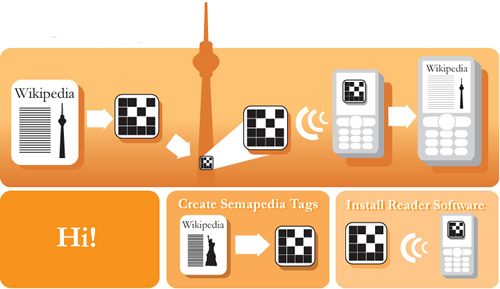
Shazam | We have already written about Shazam , an audio recognition service that continues to evolve. Shazam allows mobile users, hearing a beautiful song, to find out how it is called just by calling 2580 and sending the phone to the source of the music, after which a text message (SMS) with the artist’s name and song name comes. If this is not enough to satisfy someone’s need for infolasting, then we don’t know what to offer! Optionally, you can buy the appropriate composition through partners, such as Amazon.co.uk. Other services include the ability to send your friend a clip with this composition and go to your “tags” in the personal section . Shazam is growing rapidly: the company owns a base of 3.2 million tracks, the earliest of which is from the 1950s, the company has already received more than 20 million calls from all over the world, and is available in 19 countries, cooperates with more than 50 mobile operators, providing its services to 500 millions of potential mobile users from all over the world.
Will INFOLUST, like any true romantic story, turn into INFOLOVE, or will it break into INFODIVORCE? Nevertheless, despite the inevitable flaws (especially older generations unaccustomed to information transparency), we believe that this will not happen. INFOLUST opens up new opportunities for consumers and this process is inevitable. Otherwise, we would have had to turn the whole economic system over and drive it back into a bottle of gin online communications. That is why, for example, all attempts by China to resist infolasting are doomed to failure. But we digress. All of the above is only the initial stage, when technologies only grope the right way to the consumer, which, in turn, do not even suspect how much they need infolasting.
Translation from English:
Roman Ravve
This is true precisely where the constant interest and growing expectations of pampered consumers run into the harsh reality of silent buildings, merchandise, storefronts, posters, etc. Most of these objects are not able to communicate and answer questions like who, where, when and why , that is, to give the information that consumers are accustomed to count on online.
Without a doubt, this virgin info-market (INFOLUST) services market attracts a host of innovative solutions for 'ask and know'. Inspired by two-dimensional bar codes (barcode), universal shot-codes, SMS-codes, QR-codes and UP-codes appear. These codes are attached, pasted or printed on objects, which should make them “smarter”, giving them the opportunity to provide the necessary information or simply send the person to the relevant web page.
')
Obviously, this expands the infolasting ecosystem, bringing additional bonuses to inquiring minds, bravely plowing the spaces of this not simple real world. Next are a few illustrations that demonstrate what are modern infolastingovye services.

Initially, barcodes carried information in themselves, using parallel lines and spaces of different widths, but today they also use patterns from points, concentric circles, or it can be encrypted in some images. Although barcodes were originally created to transfer information about products to retailers, today this technology is rapidly pushed to the consumer (and even reproduced by the consumer himself!) To provide those who crave infolasting with the opportunity to communicate with their material environment.
Amazon ScanSearch | 27% of Japanese consumers already own cell phones that are capable of reading a bar code (source: eMarketer). This allows them to compare prices on the go: as early as November 2004, Amazon ScanSearch allows Japanese people to buy a book in a real store, read its bar code and compare it with a similar product in the Amazon.co.jp store, compare prices, and if there below, then purchase on her Amazon directly by phone.
ScanBuy | ScanBuy promotes a similar service in the USA called ScanZoom. After the buyer takes a barcode image on a product, he receives information about this product, which PriceGrabber or Amazon has, from its description and consumer ratings to prices in online stores.
According to ScanZoom, the following could be a service that will inform users about which of the nearest real stores offers a lower price for the same product.
QR code | At that time, as the barcode has information only in one single direction, the QR code ( QRcode ) places data both vertically and horizontally, which means it can hold a larger amount of information. Again in Japan, 30 million people have already installed special software for reading a QR code in their camera phones. A single image is enough and a QR square with information will be decrypted, and the user will receive additional information about the product through the built-in browser: from a web page to a themed video game and a promotional video.

Shot code | The OP3 ShotCode service was a visualistic solution on the infolasting market that consumers will surely like because, well, consumers generally love visualization. “Today, business cannot make people use their mobile phone to surf the Internet. The reason for this is that it is very long and inconvenient to type domain names on the phone. And here are Shot Codes: offline web links. Being captured on a mobile photo camera, the Shot-code immediately and without any effort takes the consumer to the appropriate web page directly by phone. Shot-code is easily created for any web address. " How it looks in life, you can see here: www.shotcode.com/data/movieformat .

mCode | And one more! In the USA, Nextcode presented its mCode , a QR-like code, which can be given any shape, including the shape of a company logo. This code refers to consumer information, such as product information. It can be assumed that the code placed on the board in the passenger waiting room refers to information about the flight status, and the code on the movie poster sends to the movie trailer.

Up code | Finns also showed themselves by presenting their own QR code: Up code ( UPCODE ). Up-code is used by many popular Finnish newspapers: for example, after reading a report about a hockey game, the reader can, by sending his phone to the Up-code, download a video with all the goals, or get fresh financial / stock news, by sending the phone to Up- company specific code (source: Antti Kaiponen, Springspotter Network ).

Color code | Four-color code The color code ( ColorCode ) is used in Japan and Korea. The color code refers to the corresponding server with digital content that is transmitted to the mobile device. This allows mobile phones, PDA and other devices to read pictures with a color code and immediately download music, video or data, be it family photos or a video clip of the World Championship 2006. Also, the Color code is used on TV, for example, by helping viewers to vote for your favorite reality show participants.

Mobot | Some pioneers of the grocery business do without special codes at all, for example, Mobot offers consumers to take a picture of an advertisement and send it to Mobot, having received information about this product in response. For example, working with ELLEgirl magazine, Mobot allows readers to purchase products, get free samples, discounts or product information from brands that they can choose. If a reader sees a pair of shoes in a magazine, then in order to find out the address of the corresponding store, you just need to send them a photo of Mobot. In addition, readers can participate in various promotions and games, as well as viral marketing campaigns that are sponsored by the brand. Mobot works with all wireless operators (no additional software is required) and advertising campaigns do not need to make any changes to existing existing media.

iScout | Mobot is by no means the only player on this field, and Neven Vision's iScout application helps mobile devices turn pictures into hyperlinks. “Users send some pictures of Neven Vision, which in return tells them some information about what is depicted on them. For example, send a photo with a painting and get an audio-visual story about this picture. Are you hungry? Just take a picture of the street and you’ll have a guide to the nearest restaurants on your phone. ”

Photo Navi Wine | Similarly, Photo Navi Wine , an infolast application distributed by mobile content provider Zeta Bridge Corp, offers to take a picture of the label on a bottle of wine and get product information. It is enough to attach a photo with a label to the letter and send it to photo@wine55.jp, and within 15-20 seconds you will find out the classification of the wine and the country of manufacture. For restaurant visitors, this can be an instant sommelier. Sony's image recognition technology even recognizes blurry or warped images taken in dark rooms and can learn about 3,000 brands that Zeta Bridge has information about. About 500 brands can be ordered directly by phone (source: Asahi Shimbun).

KoolTag | So far, we have been talking about codes created for consumers, but in the world of total CUSTOMER MADE and open-source, what about those codes that are created by consumers themselves ? Pay attention to the Singapore Tagit , which has developed a universal decoding system that works on an open platform, and can decode any type of digital codes, from a QR code and a primitive two-dimensional DataMatrix to its own Tagit-code product. But that's not all: the self-made part of this business is in the KoolTag service: “You can create a KoolTag for any message you would like to send to anyone. If you want your girlfriend to see a special secret picture, or to share with friends some personal video clip, it’s enough to create a KoolTag right on this site, print it, send it by email or just hang it in a prominent place. To view the contents of the KoolTag, you need only a cameraphone. KoolTag free service! ”.
The company expects to grow rapidly: Nokia, which owns 70% of the market in India, is going to include the Tagit application in all its multimedia phones, and in Singapore, Tagit, in collaboration with Sistic, the largest ticket distributor, is preparing to introduce a new mobile theater-viewing system. At the first stage, consumers will be able to receive their tickets to the mobile via MMS. Tickets will be sent in the form of a 2D barcode generated by the Tagit system. As the service develops, visitors will be able to use the full range of services, from watching a video trailer for a concert, choosing places, buying and receiving tickets, and all just by using a mobile phone. Tagit plans to move into the markets of South Korea, China and Europe.

Sema-code | Like the above QR code, the sema code is a two-dimensional matrix bar code that includes a URL. Using the Semacode Software Development Kit, any user can create visual tags for objects and contexts. Software that is installed on the phone of another user, will allow to find the corresponding mobile content. And since this is an open system, anyone can create as many semacode tags for any number of different URLs.

Among the interesting examples of how CUSTOMER-MADE intersects with infolasting, Semapedia can be called: users print links to Wikipedia articles in the form of a sema-code and attach them directly to the item or place to which the article is dedicated. Another example: Semacode Shop , which sells bloggers with T-shirts with a sema-code link to their personal site. If you take a picture of a person in such a T-shirt, you can immediately open his personal blog.

Shazam | We have already written about Shazam , an audio recognition service that continues to evolve. Shazam allows mobile users, hearing a beautiful song, to find out how it is called just by calling 2580 and sending the phone to the source of the music, after which a text message (SMS) with the artist’s name and song name comes. If this is not enough to satisfy someone’s need for infolasting, then we don’t know what to offer! Optionally, you can buy the appropriate composition through partners, such as Amazon.co.uk. Other services include the ability to send your friend a clip with this composition and go to your “tags” in the personal section . Shazam is growing rapidly: the company owns a base of 3.2 million tracks, the earliest of which is from the 1950s, the company has already received more than 20 million calls from all over the world, and is available in 19 countries, cooperates with more than 50 mobile operators, providing its services to 500 millions of potential mobile users from all over the world.
Will INFOLUST, like any true romantic story, turn into INFOLOVE, or will it break into INFODIVORCE? Nevertheless, despite the inevitable flaws (especially older generations unaccustomed to information transparency), we believe that this will not happen. INFOLUST opens up new opportunities for consumers and this process is inevitable. Otherwise, we would have had to turn the whole economic system over and drive it back into a bottle of gin online communications. That is why, for example, all attempts by China to resist infolasting are doomed to failure. But we digress. All of the above is only the initial stage, when technologies only grope the right way to the consumer, which, in turn, do not even suspect how much they need infolasting.
Translation from English:
Roman Ravve
Source: https://habr.com/ru/post/31162/
All Articles